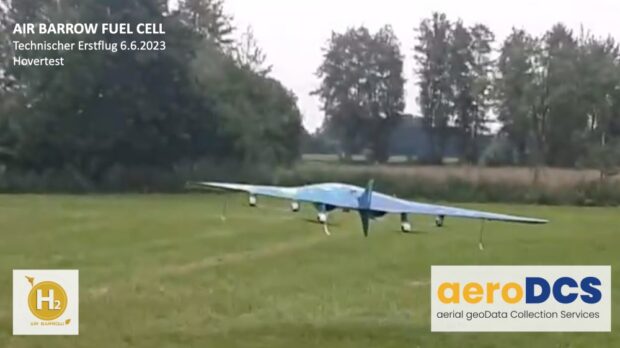The most important milestone in the Air Barrow Fuel Cell development project has now been reached. On June 6th, 2023, the drone successfully took off for the first time with hydrogen propulsion.
This makes the Air Barrow Fuel Cell the first UAV in Europe with a fuel cell drive. And in the process, a really purely European product was created: a flight carrier from Germany, a fuel cell from England, storage tanks from Italy and the connection technology from Poland. The project was therefore rightly funded with European funds.
The most difficult phase in flight is take-off and hovering. The highest level of performance is required. The fuel cell has to deliver 8 kW of power to lift the 25-kilo device into the air. In the later forward flight, only 900 watts are required. Therefore, the successful take-off and the knowledge of the energetic behavior are the most important intermediate steps in the development. These have now succeeded.
https://youtu.be/PPFBaavH0og
The values simulated and expected in advance using the test facility have now been confirmed, and the transition from theory to practice has been successful. During this flight, which lasted about 40 seconds, about 25,000 readings were recorded. Every small movement that can be seen on the video changes the energy requirement. The engineers now have to evaluate this and derive any adjustments from it.
This hovering is now repeated under different wind and temperature conditions. The cooling must be sufficient even at an outside temperature of 40°, the system must not ice up even at sub-zero temperatures.
When the practical test series for the energy supply have been completed, the transition to the transition phase will be tested. However, no problems are to be expected here, as the device itself has been flying in the battery version for some time.
AeroDCS would like to thank the team, which has been driving development for two years now. And of course also with those responsible for research funding in the state of Rhineland-Palatinate.
Thanks also to Thomas Strieker from StriekAir for the day and night-long support during development and testing. Without his experience in lightweight construction and the development and production of aircraft, we would not have been able to handle the development.
And of course many thanks to the English manufacturer of the fuel cell Intelligent Energy. The product proved to be very robust and was able to meet the specifications and performance data in all phases of the project.
The core elements of the project were thus completed on schedule and within budget. All that is now missing for marketable commissioning is the regulatory framework. The technology for flying beyond visual range (BVLOS) could also be installed, tested and put into operation. This allows the device to be remotely controlled in flight via a control station. The technology is ready – just the regulatory issues around EASA and LBA not yet. But it is being worked on and our association (UAV-DACH) is confident.
Source: Press Release



